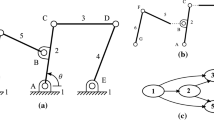Abstract
The use of a graphics processing unit (GPU) is an ideal solution for problems on data-parallel computations. The serial CPU-based program for collision analysis between a multi-body system and numerous particles is rebuilt as a parallel program that uses the advantages of a GPU. In this study, a GPU is used to effectively perform multi-body dynamic simulation with particle dynamics. The multibody system has 20 circular objects, 19 spring-damper force elements, and 2 revolute joints. The motion equations are formulated using the Cartesian coordinate system, and the implicit Hilber-Hughes-Taylor integration algorithm is used for the integral equation. To detect collisions between a multi-body system and particles or between particles, a spatial subdivision algorithm and a discrete element modeling are used. The developed program is verified by comparing the results with ADAMS. The numerical efficiencies of the serial program using CPU and the parallel program using GPU are compared according to the number of particles. The results show that the greater the number of particles, the more computing time can be saved. For example, when the number of particles is 900, the computing speed of the parallel analysis program is about five times faster than that of the serial analysis program.
Similar content being viewed by others
References
NVIDIA CUDA ™, NVIDIA CUDA C Programming Guide, Version 4.1, 2011-11-18.
NVIDIA CUDA ™, CUDA Toolkit 4.1 CUBLAS Library, PG-05326-041_v01, October (2011).
EM Photonics, Inc., CULA Reference Manual, Release R13(CUDA4.0), November 08 (2011).
J. Sanders and E. Kandrot, CUDA by examples: An introduction to general-purpose GPU programming, Addison Wesley (2011).
D. Negrut, A. Tasora, M. Anitescu, H. Mazhar, T. Heyn and A. Pazouki, Solving large multibody dynamics problems on the GPU, Math, and Comp. Science Division, ANL/MCSP1777-0710 (2010).
A. Tasora, D. Negrut and M. Anitescu, GPU-based parallel computing for the simulation of complex multibody systems with unilateral and bilateral constraints: An overview.
S. L. Grand, Broad-phase collision detection with CUDA, GPU GEMS 3, Addison Wesley (2007).
S. Green, Particle simulation using CUDA, NVIDIA Corporation (2010).
M. Tupy, A study on the dynamics of granular material with a comparison of DVI and DEM approaches, University of Wisconsin-madison (2010).
P. E. Nikravesh, Computter-aided analysis of mechanical systems, Prentice-Hall International. Inc.
A. A. Shabana, Computational dynamics, 2 Ed. Wiley-Interscience (2001).
D. Negrut, R. Rampalli, G. Ottarsson and A. Sajdak, On the use of the HHT method in the context of index 3 differencial algebraic equations of multibody dynamics, International Journal for Numerical Methods in Engineering (2000) 00:1–6.
D. Negrut, G. Ottarsson, R. Rampalli and A. Sajdak, On an implementation of the Hilber-Hughes-Taylor method in the context of index 3 differential-algebraic equations of multibody dynamics, International Journal for Numerical Methods in Engineering (2002).
N. Schafer and D. Negrut, On the potential of implicit integration methods for molecular dynamics simulation, Journal of Computational Physics (2009).
MSC Software ADAMS help, MSC Software.
Author information
Authors and Affiliations
Corresponding author
Additional information
Recommended by Editor Yeon June Kang
Jeong-Hyun Sohn has been an associate professor in the Department of Mechanical and Automotive Engineering of Pukyong National University since 2003. His interests are multi-body system dynamics, mechanism design, and dynamic analysis of vehicle system.
Chul-Woong Jun is a graduate student of mechatronics engineering at Pukyong National University. His interests are parallel computing, high-performance computing, and multi-body system dynamics.
Hye-young Jung is a graduate student of mechatronics engineering at Pukyong National University. Her interests are kinematic design and dynamic analysis of mechanical systems.
Rights and permissions
About this article
Cite this article
Jung, HY., Jun, CW. & Sohn, JH. GPU-based collision analysis between a multi-body system and numerous particles. J Mech Sci Technol 27, 973–980 (2013). https://doi.org/10.1007/s12206-013-0226-4
Received:
Revised:
Accepted:
Published:
Issue Date:
DOI: https://doi.org/10.1007/s12206-013-0226-4




